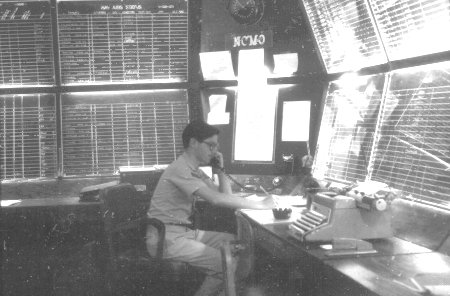|
Search This Site |

|
email Dr. SETI ® |
War Stories
From Weasel Wannabe to Weasel Keeper
copyright © 2005 by H. Paul Shuch
Society of Wild Weasels #2501
|
Search This Site |

|
email Dr. SETI ® |
From Weasel Wannabe to Weasel Keeper
copyright © 2005 by H. Paul Shuch
Society of Wild Weasels #2501
I was a s#!+-hot fighter jock who flew 200 missions over North VietNam, and took out half a dozen SAM sites.
In my dreams. In my waking hours, I was a Weasel Wannabe, a nerdy enlisted Tech Controller with coke bottle glasses who only wished that his eyesight had been better.
How I ended up enlisting in the Air Force is a classic case of snatching defeat out of the jaws of victory. I left the Electrical Engineering program at Carnegie Institute of Technology in the Spring of 1965, and just before my Student Deferment was revoked, landed a techie job offer from Bell Telephone. Since they had defense contracts, I was pretty well assured an Occupational Deferment. But when I limped in to report for work the day after Memorial Day (the limp resulting from having dropped my motorbike over the weekend, on a camping trip to Yosemite), the company doctor put me on six week's furlough. That was just long enough for the draft board to reclassify me 1A. So, I became a draft dodger. "Damned if they're going to take me against my will," I responded. "I volunteer!"
Because of my engineering background, and my lifelong Ham Radio activities, it was a given that the Air Force was going to send me through electronics school. While training as a Telecommunications Systems Controller, I applied to the Enlisted Commissioning Program, breezing through a battery of tests.
Come time for the flight physical, they took my glasses away and asked me to read the smallest line I could see.
"Line?" I squinted.
"Yes, the smallest line on the chart."
"Chart?" I replied.
"Right; the chart on the wall."
"Wall?" I inquired.
And that was the end of my dream of becoming a fighter jock.
But, I was a damned good Tech Controller, and made rank quickly enough. A year at Keesler, a year at Maxwell, and then I was assigned to the Navaids and Communications Management Office (NCMO) at Osan AFB, Korea. It was at Osan that I first crossed paths with the Wild Weasels.
The consoles of the NCMO were covered with status boards, edge-lit plexiglass panels on which we wrote in orange wax markers the condition of every major electronics facility in the theater of operations. Most facilities had cryptic names dating back to the Korean War (Osan itself, for example, showed up merely as "K55"). A monitoring station way up North was denoted as "Pueblo," and in December of 1967 I noticed a curious thing: the beam headings to that particular station kept changing. I didn't give it much thought, until the morning of 23 January 1968, when the claxons went off, and all hell broke loose.
It didn't take long to figure out what was happening. Our "receiving station" up North had been boarded, and was being towed to Wonson harbor, and we were getting ready to engage. A few kilometers up the road at Suwon AFB, the Republic of Korea Air Force (ROKAF) Combat Air Command had scrambled their handful of antiquated F-86's to lend air support. I was the NCO on duty in NCMO that morning, and the orders came swiftly down through my console, to recall the ROKAF jets. Some general, who (one would hope) had the Big Picture, made a command decision that we would not go to war that day.
Less than a week later, the first Wild Weasels blew into town. I met a few of them not on base, but in the A-Frame, a bawdy club a mile outside the main gate where all the Tech Controllers hung out, and instantly they became my heroes. They wouldn't discuss their mission, but the rumor mill had it they were going to take out the North Korean SAM and radar sites, so we could launch a rescue mission to free the crew of the USS Pueblo.
Only, none of that ever happened. That same general who had recalled ROKAF also grounded the Weasels, and it was to be eleven months of arduous negotiation before the Pueblo crew was released. The Weasels' campaign patch, hastily stitched together in one of the embroidery shops off base, read "Pueblo Wild Weasel, North Korea, 0 Missions."
A month after the surviving Pueblo crewmembers finally walked South across the Bridge of No Return, I returned to civilian life, and resumed my Engineering studies. With the ink still wet on my diploma, I applied for a job at Applied Technology, the company that made the radar warning receivers used in all the Weasel aircraft. So, for the next four years, as the war in VietNam dragged on interminably, I became a Weasel Keeper, finding better ways to keep the Weasels flying in an increasingly hostile electromagnetic environment.
When President Nixon declared Peace With Honor, and the Weasels came home, ATI lost a lot of its contracts, and I transited the revolving door of the aerospace industry, landing a position as Senior Engineering Instructor at Lockheed Missiles and Space Company, just across the street from ATI's Sunnyvale facility.
From Lockheed I transitioned into academia, going back to grad school, earning my Ph.D. in engineering, and teaching microwave electronics and ECM to a whole new generation of Weasel Wannabes. I like to think that at least one of them became a s#!+-hot fighter jock who flew 200 missions.

Sgt. Shuch on duty (NCMO, Osan AFB Korea, circa 1968)

|
Copyright © H. Paul Shuch, Ph.D.; Maintained by Microcomm this page last updated 6 August 2014 |
TOP |